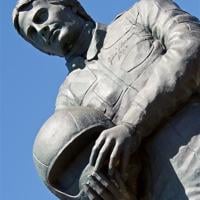
Art
After Two Decades as an Art World Outlier, Marc Dennis’s Time Has Come
On a chilly evening in mid-September, painter Marc Dennis was dining at Le Gratin, Daniel Boulud’s tony new downtown Lyonnais restaurant next to the Beekman Hotel. It was only 7 pm, but the restaurant was busy with a mix of large groups on their third martini and couples on first dates. On the walls around the diners hung three paintings Dennis loaned to Boulud specifically for Le Gratin, which opened last year: five-foot-tall realistic floral still lifes in the genre of memento mori, a reminder that death is never far away. A staple of art since the Renaissance, the genre is a favorite of Dennis’s. He’s explored the theme in still lifes of decapitated birds, dead animals procured straight from his local butcher in New Jersey, and remnants of a nefarious night out: a bedside table bearing a 9mm Smith & Wesson, bunched-up undergarments, and jewelry. But these paintings, depicting bouquets in various stages of decay, caught Boulud’s eye and have been in the restaurant since opening night. The paintings are, however, missing a detail that Dennis had originally thrown in. Laying on a thick French accent, he imitated his celebrity client. “Marc, can you please remove the beetles, would it be a trouble?” “Of course. How about snails?” “Oui!”
“Marc has always been a strong advocate for himself,” Glenn Fuhrman told me as he reached for the memory of how he first met Dennis. A MoMA trustee, Fuhrman has spent almost 20 years on the ARTnews Top 200 Collectors list, and owns pieces by the likes of Brice Marden, Juan Muñoz, Maurizio Cattelan, and Katharina Fritsch. “I saw his work in a gallery, it must have been 15 years ago, back when I was single. I thought it was pretty amazing.” It was then that Fuhrman bought the first of the eight Dennis works he owns, Art History Major, which features a girl flashing the viewer while standing in the Sistine Chapel, a pleased smirk on her face.

While his pictures today have significantly less cleavage, there is a straight line that connects Dennis’s work from the late aughts to his work today: a masterful realistic style, a reverence for the old masters, and a piquant sense of humor. It’s that combination perhaps that may have unnerved New York dealers over the years. At a glance, his work comes off as pure kitsch, bordering on camp, without the midcentury allure that makes a Warhol or a Lichtenstein so valuable. It’s not hard to imagine a dealer avoiding an artist like Dennis a decade or more ago when figurative work in such a hyperrealist style wasn’t as popular as it is today.
“He’s so technically gifted, a real master, that to some extent I think contemporary galleries viewed his work as overly academic,” Fuhrman said. “But a lot of his work transcends his style. It’s not just about photorealism. There’s much more to see and think about and discuss than how technically gifted he is.”
Dennis’s benefactors tend to talk as much about him as a person as they do about his art. Beth Rudin DeWoody, a major philanthropist and longtime Top 200 Collector, is taken with the fact that he is the director and head instructor of a career development program at the Art Students League, that he’s taught Holocaust studies as a tenured professor at Elmira College and has lectured at Cornell, and that, as a teenager, he lived on the Pine Ridge Indian reservation in South Dakota and learned the Lakota language spoken by the Sioux tribes.
Recently, Dennis has made a dramatic turn toward what he freely refers to as identity art. His latest show, Three Jews Walk into a Bar, is on view at A Hug From The Art World, a gallery started by former Gagosian gallery director (and now consultant to the gallery giant), Adam Cohen. It considers Judaism in a way few, if any, painters have done before. Each painting portrays a group of three Hasidic Jews looking at Edouard Manet’s last great work, the 1882 painting A Bar at the Folies-Bergère. In one, the men are wearing stylish Burberry jackets. In another, they are holding plastic bags that make it look as if they’ve just come from the bakery. (Flour, or perhaps powdered sugar, looks to be rubbed into one of the men’s long black coats.) Dennis gets a laugh out of a deeply religious image, mixing levity and piety in a way that both draws viewers in and makes them uncomfortable. Genuinely personal details include the lavish wallpaper behind one Manet painting, a re-creation of that from a grandparent’s home; on his mother’s side, Nana and Papi, and on his father’s, Bubbee and Zaydee. (Dennis can trace the lineage of his father’s family, the Kohens, back to Aaron, brother of the Biblical prophet Moses.) It all has roots in the artist’s past: Hasidic Judaism is a product of 18th-century western Ukraine, the home of Dennis’s Ashkenazi ancestors.

“That’s the beauty of the show,” said Cohen, the gallery owner, and a Jew himself. “Not only is it about marginalization, it’s about assimilation. And it’s about collective community and the idea ‘how did the Jews assimilate?’” Cohen sees in its format the punchline of a particular kind of joke. “The idea [of] a repeated motif…. it’s like when you tell a joke, and it’s not funny … then you tell it again and again and again. Eventually you come through the other side and it’s absolutely hilarious.”
If Dennis’s previous efforts have gone relatively unnoticed by the chattering classes, this one has hit a nerve, garnering a coveted review from New York Magazine critic Jerry Saltz, who wrote, “I’m not sure I like Dennis’s paintings, but I haven’t been able to stop thinking about them.” In his review, Saltz wonders why he thinks of the men in the paintings as “they”: “Where did this “they” come from? I’m Jewish too, after all.” The comment is not lost on Dennis. “The art world, for ten solid years, has been all about identity,” he tells me at Le Gratin, after the stuffed cabbage appetizer and before the main course, roast chicken and potatoes au gratin, a recipe Boulud took from his maman. “But people don’t look at Jews as a cultural identity. They don’t realize it’s more than a religion. Apart from Woody Allen, the Cohen Brothers, and Larry David, how much representation of Judaism is there in the creative world? And among painters, come on. There’s nothing like this work out there. I take great pride in bringing the Jewish identity into the equation.”
Recently, there has been more representation of Jewish identity in visual art, in part because of the returned specter of anti-Semitism. Last month, the organization For Freedoms put up billboards in eight American cities meant to combat hatred of Jews. One of the participating artists is Joel Mesler, who last year had a gallery show of his paintings of rabbis at Cheim & Read’s small gallery uptown. It’s a series he has pursued alongside his signature large paintings of words and phrases amid beach balls and palm fronds that he shows at David Kordansky, one of the world’s leading galleries. “What’s important about Marc’s work is that he’s keeping the culture alive,” Mesler said over the phone from his studio in East Hampton. “The fact that some weird guy who lives in Jersey is painting rabbis and Hasidic Jews … makes me happy. There are not many Jews left in the world. Something like .02 percent of the world’s population is Jewish. It would be very easy for Judaism to be just a story, like ghosts, instead of a living breathing thing.”
***
One of Dennis’s chief complaints paints him as something of an art world Rodney Dangerfield: he can’t get no New York gallery. (Dangerfield, also Jewish, was born Jacob Cohen.) His show at A Hug From The Art World is a one-off. He has representation in other cities—Gavlak Gallery, in Palm Beach and Los Angeles; K Contemporary in Denver; and Cris Worley Fine Arts in Dallas—but not in the world’s de facto art capital. It’s not that he doesn’t have the bona fides. He earned his MFA from the University of Texas at Austin, where alumni include Don Bacigalupi, former executive director of the Crystal Bridges Museum of American Art, and Michael Wellen, Tate Modern curator of international art.

But the truth is that he doesn’t really need a New York dealer; he has fans in high places. “Part of collecting contemporary art is being able to meet these artists, and share a connection with them,” said powerhouse collector Amy Phelan, who is married to investment honcho John Phelan. “Or at least for my husband and I, we really enjoy that aspect of it. Marc is more than just a terrific painter, he’s a terrific guy.” Phelan met Dennis through Fuhrman, her husband’s former partner at MSD Capital, and she too quickly bought one of his paintings after seeing it at a gallery in 2009. Like Fuhrman, she was taken by his “American Tourist in Rome” paintings. “It’s pretty naughty, but it’s beautifully painted,” she said. “I love a naughty painting.” The Phelans now own several of Dennis’s paintings, including two commissioned works, one of their daughter and another of Amy in front of a Jeff Koons balloon dog.
It was shortly after Phelan made her purchase that Dennis made the first of what would be more than 13 appearances (to date) at ArtCrush, a fundraiser for the Aspen Art Museum that is one of the art world’s glitziest events. Artists who donate a painting to the benefit auction that gets accepted are invited to attend, and there are few better places to promote yourself than in a roomful of influential high-net-worth contemporary art collectors. None of this bothers Phelan, who sits on the museum’s board. “These days you have to be a good hustler,” she said. “Just being a good painter is not enough. You have to be personable. People want to meet you, they want to like you, they want to see you. You really have to promote yourself. That’s a big change for a lot of artists.”
It was at ArtCrush that Dennis met DeWoody, who bought one of his works there. “He was so cute,” she told me, “I met him after I bought the work. He was so appreciative of it, that he said ‘I’m gonna give you a painting, as a gift. You paid a lot for that one and should get more for your money,’ which I thought was the sweetest thing.”
When asked about Dennis’s career trajectory on the outskirts of the art world, DeWoody said that his hyperrealist style may have come off as abrasive at a time when people were more interested in abstraction. But that has been changing. “Young, very talented Black artists starting to do more narrative paintings and portraits really brought that figurative style back into focus. All of a sudden, people started looking at portraits in a different way. And we’re more accepting of super realistic work,” DeWoody said. “Then … the art world caught up with him.”
The paintings at Le Gratin are themselves a sign of newfound success. Janis Gardner Cecil, the longtime curator for Chef Boulud’s art program has put Dennis in good company: her previous presentations at Restaurant Daniel have included superstar artists like Alex Katz, James Rosenquist, and Robert Mapplethorpe.
Trends are cyclical, DeWoody added, and talented artists often find themselves out of sync. “Just look how long it took Jane Dixon to build up her career. I mean, she’s been around painting beautifully forever. And now she has this huge, successful show with Karma. Similarly, David Kordansky recently announced they would represent Martha Diamond.
“Marc has always been selling, he was just never embraced by the New York gallery scene,” DeWoody continued. “It was through commissions, word of mouth, and support from his friends and collectors. Maybe, back then, it wasn’t his time yet, and now is his time.”

Art
40 Random Bits of Trivia About Artists and the Artsy Art That They Articulate – Cracked.com
[unable to retrieve full-text content]
40 Random Bits of Trivia About Artists and the Artsy Art That They Articulate Cracked.com

Source link
Art
John Little, whose paintings showed the raw side of Montreal, dies at 96 – CBC.ca
[unable to retrieve full-text content]
John Little, whose paintings showed the raw side of Montreal, dies at 96 CBC.ca

Source link
Art
A misspelled memorial to the Brontë sisters gets its dots back at last

LONDON (AP) — With a few daubs of a paintbrush, the Brontë sisters have got their dots back.
More than eight decades after it was installed, a memorial to the three 19th-century sibling novelists in London’s Westminster Abbey was amended Thursday to restore the diaereses – the two dots over the e in their surname.
The dots — which indicate that the name is pronounced “brontay” rather than “bront” — were omitted when the stone tablet commemorating Charlotte, Emily and Anne was erected in the abbey’s Poets’ Corner in October 1939, just after the outbreak of World War II.
They were restored after Brontë historian Sharon Wright, editor of the Brontë Society Gazette, raised the issue with Dean of Westminster David Hoyle. The abbey asked its stonemason to tap in the dots and its conservator to paint them.
“There’s no paper record for anyone complaining about this or mentioning this, so I just wanted to put it right, really,” Wright said. “These three Yorkshire women deserve their place here, but they also deserve to have their name spelled correctly.”
It’s believed the writers’ Irish father Patrick changed the spelling of his surname from Brunty or Prunty when he went to university in England.
Raised on the wild Yorkshire moors, all three sisters died before they were 40, leaving enduring novels including Charlotte’s “Jane Eyre,” Emily’s “Wuthering Heights” and Anne’s “The Tenant of Wildfell Hall.”
Rebecca Yorke, director of the Brontë Society, welcomed the restoration.
“As the Brontës and their work are loved and respected all over the world, it’s entirely appropriate that their name is spelled correctly on their memorial,” she said.
The Canadian Press. All rights reserved.
-

 News15 hours ago
News15 hours agoJacques Villeneuve calls thieves of late father’s bronze monument soulless idiots
-

 News15 hours ago
News15 hours agoB.C. port employers to launch lockout at terminals as labour disruption begins
-

 Politics15 hours ago
Politics15 hours agoRFK Jr. says Trump would push to remove fluoride from drinking water. ‘It’s possible,’ Trump says
-

 News15 hours ago
News15 hours agoNova Scotia Liberals release four-year $2.3-billion election platform
-
Economy21 hours ago
How will the U.S. election impact the Canadian economy? – BNN Bloomberg
-

 News15 hours ago
News15 hours agoPoilievre asks premiers to axe their sales taxes on new homes worth under $1 million
-

 News15 hours ago
News15 hours ago‘Canada is watching’: New northern Alberta police service trying to lead by example
-

 News15 hours ago
News15 hours agoAlabama Gov. Kay Ivey treated for dehydration at campaign rally



















